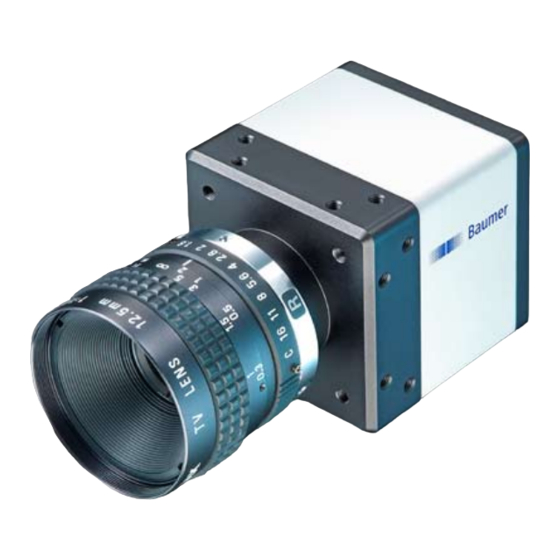Baumer SXC20 Panduan Pengguna - Halaman 14
Jelajahi secara online atau unduh pdf Panduan Pengguna untuk Kamera Digital Baumer SXC20. Baumer SXC20 48 halaman. Sxc series
cameralink cameras with truesense imaging
sensors
Juga untuk Baumer SXC20: Panduan Memulai Cepat (2 halaman)

Timings:
A - exposure time
frame (n) effective
B - image parameters
frame (n) effective
C - exposure time
frame (n+1) effective
D - image parameters
frame (n+1) effective
E - earliest possible trigger
Image parameters:
Offset
Gain
Mode
Partial Scan
14
6.2.2. Trigger Mode
After a specified external event (trigger) has occurred, image acquisition is started. De-
pending on the interval of triggers used, the camera operates non-overlapped or over-
lapped in this mode.
With regard to timings in the trigger mode, the following basic formulas need to be taken
into consideration:
Case
t
< t
exposure
readout
t
> t
exposure
readout
6.2.2.1. Overlapped Operation: t
In overlapped operation attention should be paid to the time interval where the camera is
unable to process occuring trigger signals (t
exposures. When this process time t
external events again.
After t
has elapsed, the timing of (E) depends on the readout time of the current im-
notready
age (t
) and exposure time of the next image (t
readout(n)
formulas mentioned above (no. 1 or 3, as is the case).
In case of identical exposure times, t
tion.
Trigger
t
t
Exposure
Readout
TriggerReady
Flash
(1)
t
earliestpossibletrigger(n+1)
(2)
t
= t
notready(n+1)
exposure(n)
(3)
t
earliestpossibletrigger(n+1)
(4)
t
= t
notready(n+1)
exposure(n)
exposure(n+2)
). This interval is situated between two
notready
has elapsed, the camera is able to react to
notready
exposure(n+1)
remains the same from acquisition to acquisi-
notready
t
min
triggerdelay
t
exposure(n)
exposure(n+1)
t
readout(n)
t
notready
t
t
flash(n)
flash(n+1)
t
flashdelay
Formula
= t
- t
readout(n)
exposure(n+1)
+ t
- t
readout(n)
exposure(n+1)
= t
exposure(n)
= t
exposure(n+1)
). It can be determined by the
t
readout(n+1)
